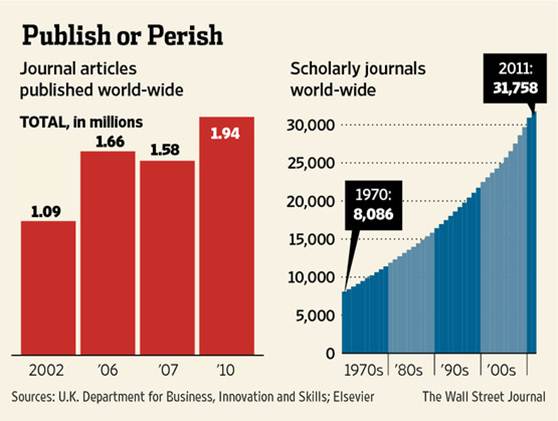Main Menu
Welcome
A few days ago, I've reported on the sevices of the library at my new institution, the University of Regensburg. Besides already archiving our raw data and getting ready to host Git repositories with our software (both citable by using stable URLs), our library currently publishes four open access journals and offered me to start new ones if I had any plans to do so. Given that there are currently about 9,000 universities on this planet, most if not all of which have their own libraries, we could easily fit all the existing ~32,000 journals in a library-based publishing venture, if all university libraries would just offer the same services our library is offering: 4 open access journals.

Assuming that most running costs of publishing these almost 2 million articles per year stays constant during the transition, each participating institution faces the opportunity to save up to 40% of their annual subscription budget, or the tax-payer about US$5b annually world-wide, taken together. That's a rare opportunity indeed: provide a huge public service not only without additional costs but actually at great savings. Obviously, this is very different from the projected costs detailed, e.g. in the so-called Finch Report, where huge sums have been suggested to be required for a transition to universal open access. The example of our library shows: a library-based transition to universal open access will not cost a dime - it will save billions. One has to wonder: why didn't the people working on the Finch report get the idea to turn to libraries as the most obvious (and most cost-effective) place to archive the products of scholarly work?
P.S.: The above does of course not imply that I'd believe we'd want to keep roughly 32k different journals, not even for a second. 'Journal' is an outdated format and there are many superior publishing formats available and many more imaginable, but this will be part of a later post. So not that we would, but we could

Assuming that most running costs of publishing these almost 2 million articles per year stays constant during the transition, each participating institution faces the opportunity to save up to 40% of their annual subscription budget, or the tax-payer about US$5b annually world-wide, taken together. That's a rare opportunity indeed: provide a huge public service not only without additional costs but actually at great savings. Obviously, this is very different from the projected costs detailed, e.g. in the so-called Finch Report, where huge sums have been suggested to be required for a transition to universal open access. The example of our library shows: a library-based transition to universal open access will not cost a dime - it will save billions. One has to wonder: why didn't the people working on the Finch report get the idea to turn to libraries as the most obvious (and most cost-effective) place to archive the products of scholarly work?
P.S.: The above does of course not imply that I'd believe we'd want to keep roughly 32k different journals, not even for a second. 'Journal' is an outdated format and there are many superior publishing formats available and many more imaginable, but this will be part of a later post. So not that we would, but we could

Posted on Monday 14 January 2013 - 13:33:30 comment: 0
{TAGS}
{TAGS}
You must be logged in to make comments on this site - please log in, or if you are not registered click here to signup
Render time: 0.0662 sec, 0.0073 of that for queries.





